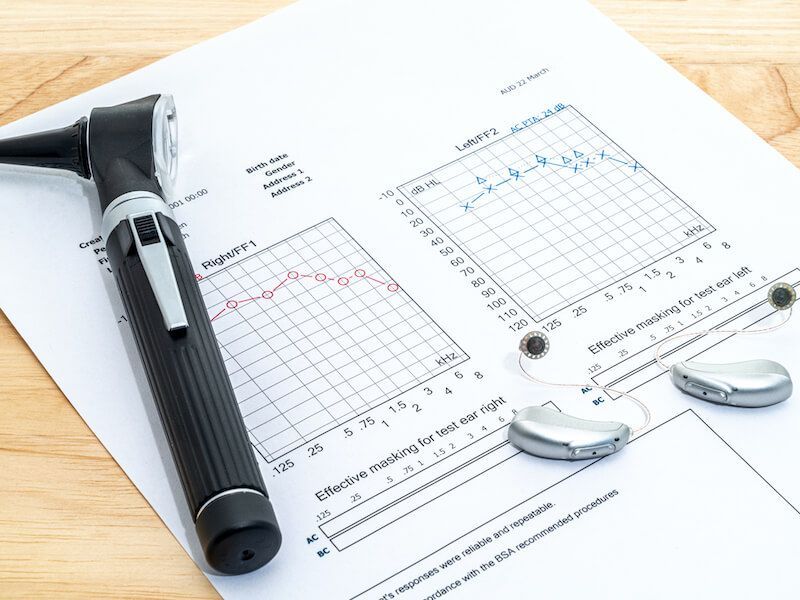How to Interpret Your Hearing Test or Audiogram

Measuring hearing loss is more technical than it may seem at first. You can probably hear certain things clearly at lower volumes but not others. You may confuse certain letters like “S” or “B”, but hear other letters perfectly fine at whatever volume. It will become more apparent why you notice inconsistencies with your hearing when you learn how to interpret your hearing test. Because simply turning up the volume isn’t enough.
How do I read the results of my audiogram?
Hearing professionals will be able to get a read on the state of your hearing by utilizing this type of hearing test. It won’t look as straightforward as a scale from one to ten. (Wouldn’t it be wonderful if it did!)
Many people find the graph format challenging at first. But if you are aware of what you’re looking at, you too can interpret the results of your audiogram.
Reading volume on an audiogram
On the left side of the chart is the volume in Decibels (dB) from 0 (silent) to around 120 (thunder). This number will identify how loud a sound has to be for you to be able to hear it. Higher numbers signify that in order for you to hear it, you will need louder sound.
If you’re unable to hear any sound until it reaches about 30 dB then you’re dealing with mild hearing loss which is a loss of volume between 26 and 45 dB. You have moderate hearing loss if your hearing starts at 45-65 dB. Hearing loss is severe if your hearing starts at 66-85 dB. If you are unable to hear sound until it gets up to 90 dB or more (louder than the volume of a running lawnmower), it means that you have profound hearing loss.
Examining frequency on a audiogram
You hear other things besides volume also. You hear sound at different frequencies, commonly called pitches in music. Different types of sounds, including letters of the alphabet, are distinguished by frequency or pitch.
Frequencies that a human ear can hear, ranging from 125 (lower than a bullfrog) to 8000 (higher than a cricket), are normally listed along the bottom of the graph.
We will check how well you hear frequencies in between and can then plot them on the chart.
So if you’re dealing with hearing loss in the higher wavelengths, you may need the volume of high frequency sounds to be as high as 60 dB (the volume of somebody talking at an elevated volume). The volume that the sound needs to reach for you to hear each frequency varies and will be plotted on the graph.
Why tracking both volume and frequency is so significant
Now that you know how to read your hearing test, let’s have a look at what those results might mean for you in real life. Here are a few sounds that would be tougher to hear if you have the very prevalent form of high frequency hearing loss:
- Women and children who tend to have higher-pitched voices
- “F”, “H”, “S”
- Whispers, even if hearing volume is good
- Birds
- Beeps, dings, and timers
- Music
While a person with high-frequency hearing loss has more difficulty with high-frequency sounds, certain frequencies might seem easier to hear than others.
Inside of the inner ear tiny stereocilia (hair-like cells) shake in response to sound waves. If the cells that pick up a specific frequency become damaged and eventually die, you lose your ability to hear that frequency at lower volumes. If all of the cells that pick up that frequency are damaged, then you completely lose your ability to hear that frequency regardless of volume.
Interacting with others can become very aggravating if you’re dealing with this type of hearing loss. You might have difficulty only hearing certain frequencies, but your family members might assume they have to yell in order for you to hear them at all. In addition, those with this kind of hearing impairment find background noise overpowers louder, higher-frequency sounds like your sister talking to you in a restaurant.
We can use the hearing test to personalize hearing solutions
We will be able to custom tune a hearing aid for your particular hearing needs once we’re able to comprehend which frequencies you’re not able to hear. In modern digital hearing aids, if a frequency enters the hearing aid’s microphone, the hearing aid immediately knows if you can hear that frequency. The hearing aid can be fine tuned to boost whatever frequency you’re having trouble hearing. Or it can alter the frequency through frequency compression to a different frequency you can hear. Additionally, they can enhance your ability to process background noise.
Modern hearing aids are programmed to target your particular hearing requirements instead of just turning up the volume on all frequencies, which creates a smoother listening experience.
If you think you may be dealing with hearing loss, call us and we can help.


